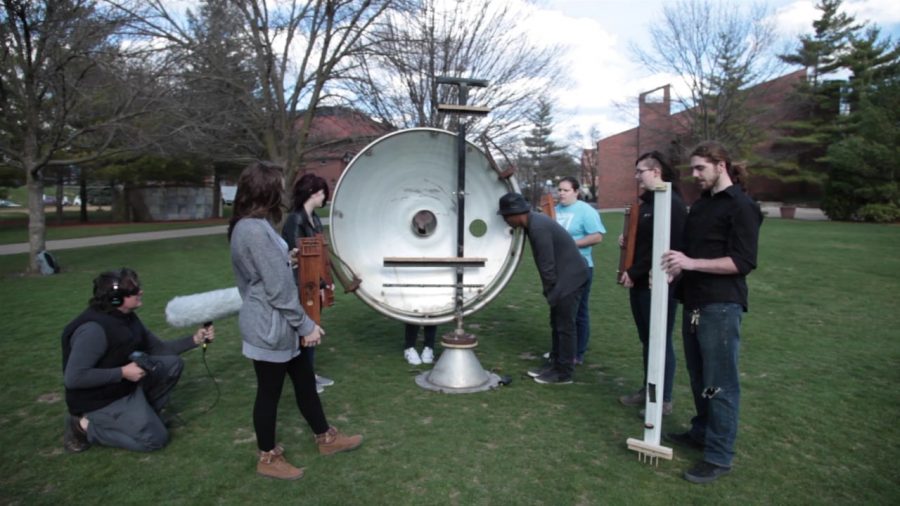Millikin’s Spelling the Wind
1988 BFA Millikin Alum and Georgia State University Professor, Craig Dongoski, has been working with Millikin University and its students since Fall 2015 to create his multimedia project, Spelling the Wind.
Being from Decatur, Dongoski eventually got his degree from Millikin specializing in sculpture and printmaking an eventually got his graduate degree in South Dakota for printmaking.
In the artist statement on his website, drawingvoices.com, Dongoski talks about how in his works he attempts to “expose the nervous system.” He also talks about his experience meeting Panzee, a “language-trained chimpanzee who has an extraordinary ability to write (a hidden language possibly).” Dongoski believes that this encounter altered the “context and content” of his work. From this experience, Dongoski copies “Panzee’s marks just like one would copy characters to learn, internalize, metabolize any other language.” This experience has followed him and his art to this day.
Today, Dongoski’s focus is Spelling the Wind. This project consists of “Aeolian Wind Harps, drawing, percussion, cupules, and biofeedback as a means to explore the various connections between the aural and visual realms,” according to the Vimeo video on the project. Dongoski also explains in the video that the Aeolian harps he used are not typical Aeolian harps. The resonators on these harps are, in fact, crop circles in order to be appropriate for the region. He also tells that the Aeolian harps do not allow one to intervene as a musician, rather, the natural wind is the one playing it.
After hammering away at rocks in class and recording marks on paper or other mediums, Dongoski is often asked by students, “What am I doing?” In the video he explains, “We’re exploring your birthright…Why can’t everyone make a mark? Why can’t everyone make a sound…?” He emphasizes that, “the audio artifact of mark making is an area of mark making that hasn’t been considered.” Dongoski says, “It is very interesting to me..along with the cupules too because it’s a mark. We start thinking about the mark- the mark on nature or actually taking something out of the Earth. This is a radical notion with it…we can change the way we think about art making and art itself.”
During the spring semester last year at Millikin, Dongoski had a handful of students he was working with for this project. They can be seen practicing and exploring the audio effects Dongoski uses in this project. They also created some pieces in the class that are featured in the exhibition. Dongoski’s exhibition runs from August 29-September 30, 2016 in KFAC’s Perkinson Gallery.
Once inside the gallery, the pieces confuse, yet intrigue the audience. Two large pieces are surrounded by smaller pieces. Basically, they consist of line drawings with a ballpoint pen-a medium not typically used in art, rather used for writing. This is intentional. Dongoski states, “they are as much about writing as they are about drawing.” In the end, he has the audience question, “where does drawing end and writing begin?” and vice versa.
Dongoski states, “I follow the imperfections of the lines and those imperfections become amplified and exaggerated as the drawing evolves. To me it’s kind of an expression of evolution, like evolution occurs from a mutation. They are drawings of time, in a way. The smaller ones in particular I think of them as record albums, but I also think of them as brains. They are a form of biofeedback.”
The live performance will be held on the equinox, Thursday, September 22, from 4-6 pm. Dongoski emphasizes that “this exhibition is of process, not project” and that it truly doesn’t have a beginning or end. He hopes its audience will learn that art does not need to be so subjective, rather one needs to begin to explore what art can be. As well, Dongoski wishes that this will perform as a way of presenting other models of teaching. The exhibition is made to present more than just be an entertaining exhibit.
Ultimately, Dongoski states, “We’ve been exploring multidisciplinary ways of teaching and…making the barriers of medium, of disciplines sort of non-existent.” In the end, he asks, “Are we making sculpture? Are we making sound? Are we making drawings? Are we making paintings? Yeah, maybe. Yeah, no. It doesn’t really matter. We are just expressing.”

